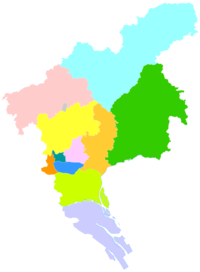
The Guangzhou Metro is the rapid transit system of the city of Guangzhou in Guangdong Province of China. It is operated by the state-owned Guangzhou Metro Corporation and was the fourth metro system to be built in mainland China, after those of Beijing, Tianjin, and Shanghai.
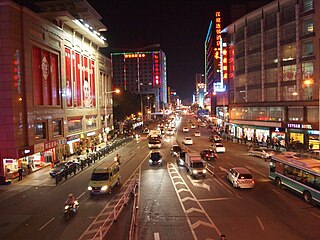
Panyu, alternately romanized as Punyu, is one of 11 urban districts of the prefecture-level city of Guangzhou, the capital of Guangdong Province, China. It was a separate county-level city before its incorporation into modern Guangzhou in 2000. The present district covers an area of about 530 km2 (200 sq mi).
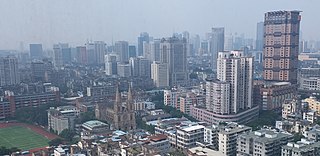
Yuexiu District is one of 11 urban districts of the prefecture-level city of Guangzhou, the capital of Guangdong Province, China, located west of the Tianhe District and east of the Liwan District. It is the commercial, political and cultural centre of Guangdong and noted for its high-quality education. The Guangdong provincial government and the Guangzhou city government are both located in the Yuexiu District. Established in 1960, the district absorbed the former Dongshan District in May 2005 along with several former subdistricts of the Baiyun and Tianhe district. Yuexiu District has 18 streets under its jurisdiction. The total area is 33.8 square kilometers. According to the seventh census data, as of 0:00 on November 1, 2020, the resident population of Yuexiu District was 1,038,643.

Liwan District is one of 11 urban districts of the prefecture-level city of Guangzhou, the capital of Guangdong Province, China. The district is split into two parts by the Pearl River: Xiguan in the northeast and Fangcun in the southwest.

Huadu District is one of 11 urban districts of the prefecture-level city of Guangzhou, the capital of Guangdong, China. It is located in the far northern suburbs of the city.

Sun Yat-sen University Station is a station on Line 8 of the Guangzhou Metro that started operations on 28 June 2003. It is located under Xingang Road West (新港西路) and Lixin Road (立新路) in the Haizhu District of Guangzhou. Its name is derived from the nearby Sun Yat-sen University.

Kecun Station is an interchange station between Lines 3 and 8 of the Guangzhou Metro. It started operations on 28 June 2003. It is located at the underground of Kecun Village in Haizhu District.

Wanshengwei Station is an interchange station between Lines 4 and 8 of the Guangzhou Metro, and also the terminus of Line 8. It started operations on 26 December 2005. It is an underground station and located near the junction of Xingang East Road (新港东路) and Xinjiao South Road (新滘南路) in Haizhu District.

Canton Tower Station is an interchange station on Line 3 and Zhujiang New Town Automated People Mover Systems of the Guangzhou Metro. It started operations on 28 December 2005. It is an underground station located to the south of Binjiang Road East in Haizhu District, on the south bank of the Pearl River.

Lijiao Station is an interchange station on Line 3 of the Guangzhou Metro and Guangfo line that started operations on 28 December 2006. It is located under Lijiao Village (沥滘村) in the Haizhu District of Guangzhou. The Guangfo line was planned to open in 2010 but finally opened on 28 December 2018.

Guanzhou Station is a station of Line 4 of the Guangzhou Metro. It started operations on 26 December 2005. It is located at the underground of the central part of Guanzhou Island in Haizhu District. It was constructed to cope with the planned Guangzhou International Biological Island", a science and technology development zone led by biological industry that opened in 2011.

Jushu Station, formerly Fangcun Sports Center Station (芳村体育馆站) or Jucun Station (菊村站) during planning, is a metro station on the Guangfo Line. It is located under the southwest of the Fangcun Sport Center (芳村体育中心) in Fangcun, Liwan District, Guangzhou. It started operation on 3 November 2010.
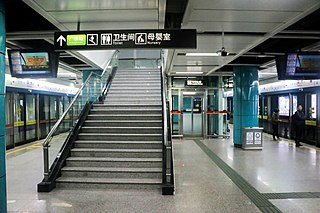
Nanzhou Station, formerly Nanzhou Coach Station (南洲客运站) during its planning stages, is an interchange station between Line 2 on the Guangzhou Metro and the Guangfo Line.

Shayuan Station is an interchange station of Guangzhou Metro Line 8 and Guangfo Line. It is located at the underground of the junction of Rongjing Road and Gongye Avenue North in Haizhu District. It was put into service on November 3, 2010. The Guangfo Line service has entered operations on December 28, 2015.

Line 8 of the Guangzhou Metro is a north-west L-shaped line on the system that runs from Jiaoxin to Wanshengwei, spanning a total of 33.9 km (21.1 mi) with 26 stations. It interchanges with Line 1 at Chen Clan Academy, Line 2 at Changgang, Line 3 at Kecun, Line 4 at Wanshengwei and Line 6 at Cultural Park. All stations on Line 8 are underground. Line 8's color is teal.
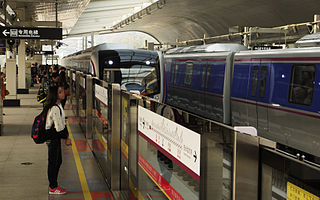
Line 6 of the Guangzhou Metro runs from Liwan District to Huangpu District. It starts at Xunfenggang and ends at Xiangxue, interchanging with Line 5 at Tanwei and Ouzhuang; Line 1 at Huangsha and Dongshankou; Line 8 at Cultural Park; Line 2 at Haizhu Square; Line 21 at Suyuan; Line 3 at Yantang and Tianhe Coach Terminal. The total length is 41.9 km (26.0 mi) with 32 stations. Line 6 serves densely populated areas including residential communities in Jinshazhou, the pedestrian street in Beijing Lu and wholesale markets in Shahe. Nevertheless, Line 6, which runs four-car trains, has long had a questionable train capacity. The phase one section between Xunfenggang and Changban began to provide service from 28 December 2013 with the exception of Yide Lu and Shahe stations. Yide Lu opened over a year later on 28 January 2015. The second phase of Line 6 from Changban to Xiangxue has been in operation since 28 December 2016. Like Lines 4 and 5, Line 6 is equipped with linear induction motor technology. Line 6's color is maroon
The Foshan Metro is the rapid transit system of the city of Foshan in Guangdong, China. Guangfo line is operated by Guangzhou Metro Corporation, and all other lines will be operated by the state-owned Foshan Rail Transit Group. It is the tenth metro system to be built in mainland China. Construction began in 2002 and the first line opened on 3 November 2010. The metro system has two new lines and one extension under construction.
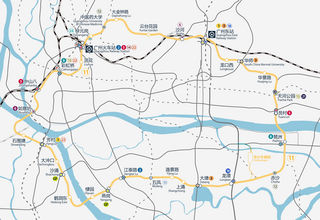
Line 11 of the Guangzhou Metro is a rapid transit rail line under construction in Guangzhou. It will be a loop line around the city center, connecting Guangzhou railway station, Guangzhou East railway station, Pazhou, and Fangcun.

Guangzhou Tram is the tram system in Guangzhou, Guangdong province, China. It is operated by Guangzhou Tram Corporation, a wholly owned subsidiary of Guangzhou Metro Corporation.
Guangzhou Metro Line 24 is a planned rapid transit line of the Guangzhou Metro. The whole line runs roughly from north to south, connecting Huadu District, Baiyun District, Yuexiu District and Haizhu District, and connects two railway hubs, Guangzhou North railway station and Guangzhou Baiyun railway station.


